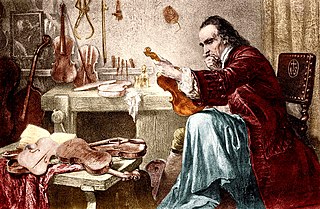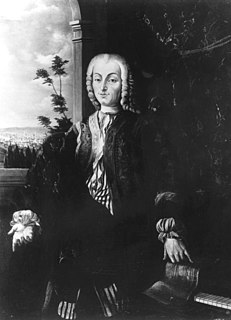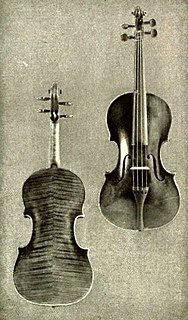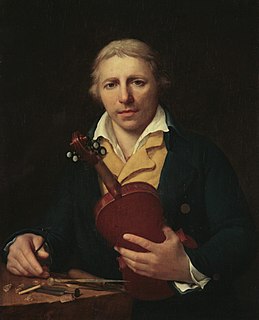Related Research Articles

Antonio Stradivari was an Italian luthier and a craftsman of string instruments such as violins, cellos, guitars, violas and harps. The Latinized form of his surname, Stradivarius, as well as the colloquial Strad are terms often used to refer to his instruments. It is estimated that Stradivari produced 1,116 instruments, of which 960 were violins. Around 650 instruments survive, including 450 to 512 violins. His instruments are considered some of the finest ever made, and are extremely valuable collector's items.

François Xavier Tourte was a French bow maker who made a number of significant contributions to the development of the bow of stringed instruments, and is considered to be the most important figure in the development of the modern bow. Because of this, he has often been called the Stradivari of the bow.

A Stradivarius is one of the violins, violas, cellos and other string instruments built by members of the Italian family Stradivari, particularly Antonio Stradivari, during the 17th and 18th centuries. They are considered some of the finest instruments ever made, and are extremely valuable collectors items.

Bartolomeo Cristofori di Francesco was an Italian maker of musical instruments famous for inventing the piano.

The National Music Museum: America's Shrine to Music & Center for Study of the History of Musical Instruments (NMM) is a musical instrument museum in Vermillion, South Dakota, United States. It was founded in 1973 on the campus of the University of South Dakota. The NMM is recognized as "A Landmark of American Music" by the National Music Council.

A fortepiano[ˌfɔrteˈpjaːno], sometimes referred to as a pianoforte, is an early piano. In principle, the word "fortepiano" can designate any piano dating from the invention of the instrument by Bartolomeo Cristofori in 1698 up to the early 19th century. Most typically, however, it is used to refer to the mid-18th to early-19th century instruments for which composers of the Classical era, especially Haydn, Mozart, and the younger Beethoven wrote their piano music. Starting in Beethoven's time, the fortepiano began a period of steady evolution, culminating in the late 19th century with the modern grand. The earlier fortepiano became obsolete and was absent from the musical scene for many decades. In the 20th century the fortepiano was revived, following the rise of interest in historically informed performance. Fortepianos are built for this purpose today in specialist workshops.

Jean-Baptiste Vuillaume was a French luthier, businessman, inventor and winner of many awards. His workshop made over 3,000 instruments.

The Lipinski Stradivarius is an antique violin constructed in 1715 by the Italian luthier Antonio Stradivari of Cremona, during Stradivari's "golden period" between 1700 and 1725. There are fewer than 650 extant Stradivarius violins in the world today, and the Lipinski is considered to be a particularly fine example. In 2012, it was appraised at US$5 million.

The Royal Academy of Music Museum is a museum of musical instruments and artefacts and research centre of the Royal Academy of Music in London.

Carlo Bisiach (1892–1968) was a violin maker born in Milan Italy. Bisiach's work contributed to the rebirth of violin making in the region after the difficult times of World War I and World War II. After working with his father Leandro in Milan and then Siena, Carlo established himself at Florence in 1922. The most talented of Leandro's sons, Carlo went on to develop his own style quite separate from the Antoniazzi-derived work of his father and brothers.

Leandro Bisiach was an Italian violin maker, who was born in Casale Monferrato and died in 1945 at Venegono Superiore near Varese.
The Jupiter Stradivarius is a violin constructed in 1700 by luthier Antonio Stradivari of Cremona. It is one of only 700 extant Stradivari instruments in the world today.

Nicolas Lupot was one of the most illustrious French luthiers of his time.

David Laurie - was a distinguished 19th century violin collector.

Hottinger Collection – formed in New York City by Henry Hottinger.

Tarisio Auctions is a web-based auction house that specializes in string instruments and bows. Founded in 1999 with locations in New York and London, its online auctions provide a global marketplace for musical instrument sales.

Nicola Amati, Nicolò Amati or Nicolao Amati was an Italian master luthier from Cremona, Italy. Amati is one of the most well-known luthiers from the Casa Amati. He was the teacher of illustrious Cremonese School luthiers such as Andrea Guarneri and Giovanni Battista Rogeri. While no clear documentation exists for their being apprentices in his shop, Amati may also have apprenticed Antonio Stradivari, Francesco Rugeri, and Jacob Stainer, as their work is heavily influenced by Amati.
Keith Richard Hill is a prize winning American maker of musical instruments He has conducted research into the acoustical technology employed by musical instrument makers from 1550–1850, and used this knowledge to create hundreds of harpsichords, clavichords and other instruments.
Sonya Monosoff is a violinist, a pioneer of the Baroque violin and one of the first American performers to use the Baroque violin in performance.
References
- ↑ Comment from Manze's review of Pollens's book Stradivari in Early Music (May 2011): 269-270
- ↑ Roger Starr, “The Hidden Rooms Behind Museum Displays,” City Journal 5/2 (Spring, 1995): 104-107; The Metropolitan Museum of Art Annual Report for the years 1976-2006.
- ↑ "The Talk of the Town," The New Yorker, November 24, 2008
- ↑ Jabberwocky #82, vol. 22, no. 2 (Spring, 1993), Knight Letter # 45 (Summer, 1993).
- ↑ "Ornamental Ornithology," The Strad vol. 118, no. 1410 (October, 2007): 34-40.
- ↑ "Recipe for Success," The Strad vol. 120, no. 1429 (May, 2009): 34-38. Stewart Pollens, Stradivari: 262-279
- ↑ These include The Wall Street Journal (March 11, 1999), The Times (London) (March 15, 1999; October 27, 2000; November 11, 2001; November 26, 2001), Le Figaro (December 7, 2000), La Stampa (March 28, 1999), The Strad (August, 2001), Attache (September, 1999), Money (June, 2002), Forbes.com (April 22, 2002) and Metropulse.com (February 17, 2001).